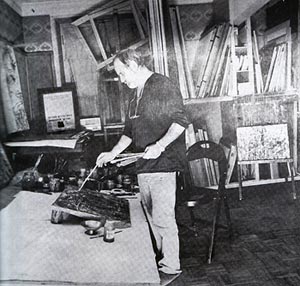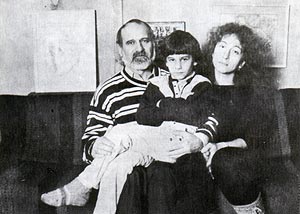Elena Zukova. About the artist
«Thence we came forth.
to rebehold the stars».
Dante Alighieri.
Divine Comedy. Inferno.
Man's perception of Spirit, Being and Eternity finds its expression in Art. This is what we find so attractive in Bysantine and Russian medieval art. But we seek the same thing in the chilly geometrical forms of that bold discoverer of new forms Kazimir Malevich and in the enchanted space of the abstract paintings by Vasily Kandinski. Russian painting, with its bent for the synthetic medium, has trodden its own road to Calvary and, in the recent decades, has begotten a multitude of trends, which seem to be mutually exclusive. A contemporary artist, who has renounced the socialist-realist principle of photographic reflection, faces the formidable task of expressing the multifarious reality in "code" and escaping the confines of "sots-art" ("social art"), which has been begotten by the social situation in the country and already elevated — or debased — to the rank of a fashionable trend.
Nikolai Estis has happily evaded all these pitfalls. He does not try to measure up to any of the existing trends. He stands apart from the highroad of modern vanguard painting, which seems committed to the task of grafting nihilism on public consciousness. Recognition is secondary for this artist, his goal is self-expression, the blazing of his own path and the realisation of his own artistic mission. He paints without taking account of time as a calendar concept, and Time as a philosophical concept is in league with him.
 Nikolai Estis "found himself" in the 1970s, when he was no longer a young man. An earlier evolution of the original artist in him was prevented not only by the adverse circumstances of artistic life in Russia in the 50s and 60s, but also by his failure to find congenial mentors from among his senior contemporaries. His apprenticeship was spent in the school of life rather than the school of art, and the lessons taught were harsh indeed. And yet he found faith in himself. It is as though one day, in his garret-studio in the centre of Moscow, he had a vision of a star-filled chasm of heavens and plunged into this chasm —away from painful reality—taking with him all that he loved, grieved for and believed in. He addressed himself to the eternal, that precludes all falsehood, and this safeguarded him from compromise in the hard years when he was deprived of the opportunity to exhibit his pictures. As the result, he arrived into the present-time new reality, when all the prohibitions have been swept away, not a nouveau riche but a mature artist, who offers us, the viewers, the fruit of much thought, feeling and suffering.
Nikolai Estis "found himself" in the 1970s, when he was no longer a young man. An earlier evolution of the original artist in him was prevented not only by the adverse circumstances of artistic life in Russia in the 50s and 60s, but also by his failure to find congenial mentors from among his senior contemporaries. His apprenticeship was spent in the school of life rather than the school of art, and the lessons taught were harsh indeed. And yet he found faith in himself. It is as though one day, in his garret-studio in the centre of Moscow, he had a vision of a star-filled chasm of heavens and plunged into this chasm —away from painful reality—taking with him all that he loved, grieved for and believed in. He addressed himself to the eternal, that precludes all falsehood, and this safeguarded him from compromise in the hard years when he was deprived of the opportunity to exhibit his pictures. As the result, he arrived into the present-time new reality, when all the prohibitions have been swept away, not a nouveau riche but a mature artist, who offers us, the viewers, the fruit of much thought, feeling and suffering.
The impact made by the works of Nikolai Estis depends on the individuality of the viewer, on whether or not he is informed in the history of art, on his tastes and preferences in old and modern painting, and, the most important thing, on his awareness of himself as a part of Providence's overall design.
The picture of the world that arises on Estis's canvasses is grandiose and dramatic. The dynamic space in his compositions is alluringly infinite, suggesting a continuation in the directions indicated. In fact, any fragment of the painted texture also contains the infinity, as it were. Hence the impression of being in the presence of both macro- and microcosm, of time that is beyond the earthly bounds. The wealth of colour and rhythmic structures, the spectral light which lends harmony to the fantastic gamut of colours — all combine to produce the impression of boundless depth of space confined within the rectangle of the picture. Incorporeal anthropomorphous figures which emerge in many compositions at the crossing of lines of force of this complex space, developed, as it were, by means of light, lend solemn or tragic overtones to these colour symphonies. The symbolism of the figures has varying degrees of definiteness, but they are undoubtedly rooted in the soil of the Bible, as well as in the Byzantine-Russian tradition. The harmony of these works exerts an irrational, almost mystical attraction.
The temporal, dynamic aspect of abstract painting, which is, essentially, the attainment of the 20th century and the embodiment of contemporary world perception, is present in the work of Nikolai Estis as a genetically inherent quality. But his worlds are a special spiritual substance. At the cost of a superhuman effort, he overcomes the entropy of mindlessness to force his way, through the wreckage of the past and the chaotic superimpositions of matter dissolved in time, to the sources of Spirit and Beauty. Estis's nostalgic memory is not turned to the past, but to the eternal, and, consequently, to the future.
 Nikolai Estis is not entirely divorced from his own time. Some of his themes, "Birds", for instance, or "Figures", seem to afford him such an inexhaustible emotional fount that he returns to them again and again. One perceives them as short lyrics against the background of long poems — his cycles of recent years. The associative chains have been growing ever more complex, as the mythological aspect expanded in variety and scope. His paintings add up to a symbolic portrayal of the world, in which the dramatis personnae are the Creator, the Human Kind, History, Spirit, combatting the chaos of passions, Life and Death...
Nikolai Estis is not entirely divorced from his own time. Some of his themes, "Birds", for instance, or "Figures", seem to afford him such an inexhaustible emotional fount that he returns to them again and again. One perceives them as short lyrics against the background of long poems — his cycles of recent years. The associative chains have been growing ever more complex, as the mythological aspect expanded in variety and scope. His paintings add up to a symbolic portrayal of the world, in which the dramatis personnae are the Creator, the Human Kind, History, Spirit, combatting the chaos of passions, Life and Death...
It would be futile to try and define the content of such painting in words—it lends itself to it as little as music does. Estis is alien to concreteness and didacticism, he is not out to impose anything on the viewer. His aim is merely to convey his own inner condition. He is not an artist inclined to theorizing. His gift is for feeling, loving and suffering — and for conveying this with his brush on canvas and paper. The viewer finds himself thrilled to the core by the sensuous wealth of his paintings, which radiate enormous power in the rhythms of colour combinations, in the centripetal efforts to possess the eternity of the Universe.
Nikolai Estis works in bouts, as it were, immersing himself in painting for some two or three months running. During these "bouts" he seems to isolate himself from real forms and natural colours. He usually works on several compositions simultaneously, each of them independent, yet all interconnected and constituting a cycle, and he keeps returning, in a curcuit, to each canvas or sheet. He uses tempera, a pliable medium, which accords best with his method of passionate immersion in the process of painting. To deepen the plastic ideas of compositions, born of an impulse, he enriches them through comparison, juxtaposition and contrast. The impulsive origins remain a part of the pattern of imagery and are preserved in the finishing when the intense painting is supplemented with fine brushwork. In elaborating details the artist does not fight a certain tendency for object-portrayal, which he regards as a heritage of the Russian realist school of painting.
Estis's creative method excludes all rationalism. The truth he aspires for is attained in the process of painting. This is the stimulus of his creative effort. The universe contained in the pictures of Nikolai Estis is his inner world extended in the temporal and spatial dimensions of Art.
Elena Zukova
Senior Research Assistant of The State Tretyakov Gallery



